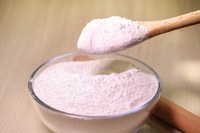Prairie Fare: Before licking the spoon, consider facts about flour and oatmeal
(Click an image below to view a high-resolution image that can be downloaded)
“I thought that eggs were the problem in raw cookie dough!” someone exclaimed to me after a webinar. “Now the flour can make us sick?”
“Yes, we have to be careful with flour,” I replied.
“Flour is a raw commodity, and some outbreaks have occurred due to Salmonella and E. coli bacteria in uncooked food containing flour,” I noted.
Eating raw cookie dough is not advised for safety reasons, with an exception.
If you love commercially made cookie dough ice cream, you can safely eat it. The cookie dough has been made with pasteurized eggs and heat-treated flour.
You will notice food safety labels on ready-to-bake cookies. These cookies are not meant to be eaten out of the container, unless it is “edible cookie dough.”
“Should I be heating the oatmeal before I make unbaked cookies?” my colleague inquired.
“That’s a great question. Oatmeal is handled differently from flour. Oats are cleaned, dehulled and then toasted or steamed before being rolled or cut. This heating step extends shelf life, prevents spoilage and destroys harmful bacteria,” I said.
“That’s why you don’t see warning labels on oatmeal containers, and why it’s safe to use oats in no-bake snacks. There are no warning labels on oatmeal cannisters about cooking it,” I added.
We had just gotten off a call where flour and oatmeal were being discussed, and the discussion had an immediate effect on my colleague.
Flour
In 2023, 14 illnesses with three hospitalizations in 13 states were linked to eating undercooked or uncooked products containing wheat flour. Most were associated with consuming raw dough, cake mix or batter.
Wheat is cleaned to remove stones, soil and other contaminants. It is tempered (or moistened) to toughen the bran, then it goes through roller mills or stone mills.
The flour is separated by sifting out the white starchy part (endosperm) that we buy as flour. The bran (outer layer) and germ (fat-containing part) are removed and can be sold as animal feed or as individual ingredients.
If the grain is ground to include all parts of the grain, then it is whole-wheat flour. The components can be blended to meet the needs of the end user, such as a baker.
Flour is not heated during the milling process, so it is “raw.”
A tested method for heat-treating flour at home has not been developed. If flour or other foods are recalled due to safety issues, throw them away or request a refund.
Be sure to wash your hands before and after handling raw flour. A food as powdery as flour can contaminate other surfaces in your kitchen. Avoid cross-contamination by cleaning work surfaces and utensils.
Do not taste raw dough or batter. Do not make raw play doughs containing flour for children’s crafts.
Oats
Like wheat, oats are grown in fields, but the processing of oats is a little different. Oat kernels are cleaned and dehulled, and then the product is “aspirated” to separate any remaining hulls.
The groats (whole kernels without the hull) are then heated to extend their shelf life. The toasting process inactivates enzymes and reduces moisture that can cause off-flavors or spoiling. The heating process also makes the oats safe to use for uncooked products such as overnight oats (made in the refrigerator) and energy bites that are not baked.
Next, the oats are rolled or cut. Quick oats, which cook in one to three minutes, are steamed as well as cut. Steel-cut oats are cut, while old-fashioned oats are cut and rolled.
Oats are good for you. They provide a soluble fiber called beta-glucans that are heart-healthy. This fiber type may help reduce our blood cholesterol. You might see a heart health claim on some oat-based foods.
If you’re craving something sweet with the same chewy texture as cookie dough, here’s a safe and simple option you can make at home.
Peanut Butter Oat Bites
¾ cup peanut butter (or other nut butter)
1 ½ cups oats (quick or old-fashioned)
⅓ cup honey
⅓ cup mini chocolate chips
2 tablespoons ground flax seed*
*Substitute coconut, dried cranberries, raisins or chia seeds if desired for the flax seed.
Place peanut butter in a microwave-safe bowl and microwave for about 20 seconds until soft. Add remaining ingredients and mix well. Use a 1-tablespoon measuring scoop or spoon to measure portions. Roll into balls. Store in an airtight container in the refrigerator.
Makes 16 bites. Each bite has 100 calories, 5.5 grams (g) fat, 2.5 g protein, 10.5 g carbohydrate and 35 milligrams sodium.
(Julie Garden-Robinson, Ph.D., R.D., L.R.D., is a North Dakota State University Extension food and nutrition specialist and professor in the Department of Health, Nutrition and Exercise Sciences.)
NDSU Agriculture Communication – Aug. 21, 2025
Source: Julie Garden-Robinson, 701-231-7187, julie.garden-robinson@ndsu.edu
Editor: Dominic Erickson, 701-231-5546, dominic.erickson@ndsu.edu




